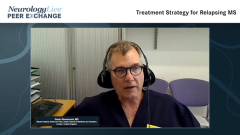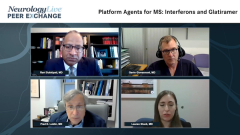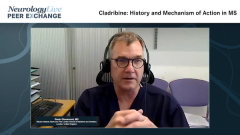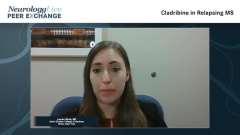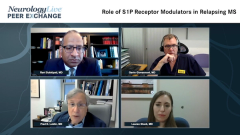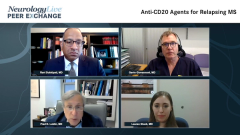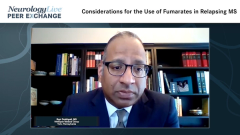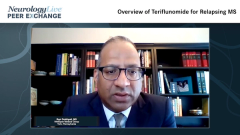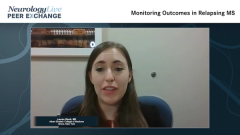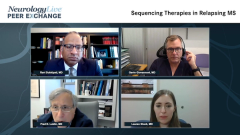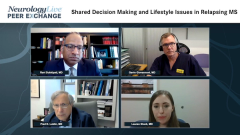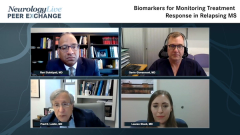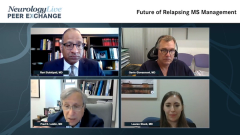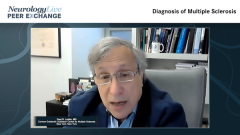
Cladribine in Relapsing MS
Key opinion leaders provide insight into the use cladribine for relapsing multiple sclerosis including durability and safety profile.
Episodes in this series

Fred D. Lublin, MD: There were a couple of abstracts recently. You’re the lead author of one of the abstracts, from the time of the first relapse. You are also a post hoc-analysis of secondary progressive. Tell us a bit about that?
Gavin Giovannoni, MD: Time to first relapse is 1 of the things because this drug depletes lymphocytes slowly. Within about 3 to 4 months of coming out, people thought this drug was very slow in onset. What’s actually happening is, as lymphocytes are being depleted, some cells are coming back so you’re seeing a depletion and repopulation of cells occurring at the same time. We know, from work, that biomarker work of the memory B-cell population drops within days to weeks. What you’re seeing is repopulation of naïve B cells. The B-cell population is switching to a naïve B-cell population. The drug works very quickly. I think the time to first relapse was showing you that the drug works quickly. We also saw that in ORACLE [antibiotics for preterm prelabour rupture of the membranes: short-term and long-term outcomes] trial. Within 3 months, you almost have full efficacy of this drug. Because it works very quickly, the majority of patients, about 84%, were free of relapses in the first year. The drug works quicker than we realized. I am beginning to think of cladribine [Mavenclad] as a small cell and anti-CD20 therapy in terms of mode of action and onset of action. The other thing, which is surprising, is durability. When you go into year 2, you still see a very similar proportion of patients, 84%, relapse free. When go into years 3, 4, and 5, the proportion of relapse-free patients is 75%. You get breakthrough activity with people who develop relapses and MRI activity but it’s in the region of about 5% to 10% per year. We use other DMTs [disease-modifying therapies] in the class of immune reconstitution therapies. You watch these patients and when they breakthrough, you can offer them a retreatment, depending on whether your peers allow it, or you could get them another treatment. In terms of secondary progression, if you use the metric driven definition— because the drug delays disability progression—it can also delay onset. I don’t like this outcome measured in clinical trials, but we can debate it. It was effective in reducing time of secondary progressive multiple sclerosis [SPMS], so very few patients, less than 10% of patients—say 6.5% of patients. The full definition of SPMS is about 50% reduction compared to the patients who are on placebo, which was 14% of patients. It’s another way of presenting the disability progression data in terms of a metrics driven system for SPMS.
Fred D. Lublin, MD: The durability issue is very interesting with this agent. We will talk a bit about this when we talk about monitoring. In year 3, the placebo group and the treated group did the same. They continued to treat in years 3 and 4, or not treating by giving placebo. Both groups yielded the same results, which I think is the durability effect you’re talking about. It’s an interesting phenomenon because we haven’t seen that before. It would be nice if we could get additional data on when to redose. We have a similar issue with alemtuzumab, where there is no data as well.
Gavin Giovannoni, MD: This is 1 of the questions we’re trying to answer with the CLASSIC-MS study. We try to get those populations back to see how long that duration is but, as you know, Fred, even the alemtuzumab population is proportion to them. I am not saying it’s the majority—it’s minority—and depending how long you follow-up with them, about 25% of them go way beyond 10 years without having any relapses or MRI activity. So the durability of alemtuzumab is beyond 10 years in proportion. Also, people who had cohorts of HSCT [hematopoietic stem cell transplantation] patients by stem cell transplant are seeing a higher proportion. I think it’s around about 40% to 45% of people who are beyond a decade of treatment without any recurrence of activity. I think some patients don’t like idea of waiting for disease activity to come back. They feel nervous but this is how these treatments work. You hopefully change the immunology of MS [multiple sclerosis] fundamentally, either kill all those autoimmune cells or when the immune system recovers, the regulatory mechanisms are intact, but the disease goes into long term remission. A proportion of these people may never need to be treated again. That’s kind of the selling point. That’s the carrot for wanting to be treated with an immune reconstitution therapy. The other side of me, from an academic and a researcher’s standpoint, is why can’t we use these treatments? We use it in the depletion phase, put them on something that’s safe, like a maintenance therapy, and keep them on that indefinitely so none of them will even need to be treated with anything else. But that hasn’t been studied. That strategy of true induction maintenance needs to be studied, particularly regarding the anti-CD20 therapies. We need an exit strategy for anti-CD20 therapies.
Fred D. Lublin, MD: That’s a good point. Ravi, Lauren, thoughts about cladribine?
Ravi Dukkipati, MD: Our approach has been that the use of cladribine does not preclude the use of any other class of therapies in the long run. In other words, patients often want to change therapies or prefer the idea of a short-term therapy. We use cladribine in that setting and while it offers high efficacy, it doesn’t compromise efficacy. Based on the data that we have, it leaves options wide open for year 3 and onwards. When we look at some of the long-term data from outside of the United States, the real-world data suggests that the majority of these patients do very well 5 years or 7 years out.
Lauren Gluck, MD: One last point I’ll throw in regards to family planning. There’s good data that if you complete your last dose of treatment, 6 months later, there’s very low to no risk of teratogenicity, even in patients who haven’t had MS for 20 years. If the patient is younger, if they’re thinking about extending their family or starting a family, this could be a good option. Let’s start you on something that’s going to work very strongly. You can get pregnant, have a baby, restart therapy, and then you will be better off.
Fred D. Lublin, MD: One last thing. When we get to safety, Gavin, there were issues around malignancy. Has that held up?
Gavin Giovannoni, MD: No. The real-life data suggests the malignancy signal was probably driven by the extremely low rate of 0 malignancies in the placebo arm, so it was because of the malignancy rate in the cladribine arm that was keeping up with what you’d expect, based on the other phase 3 results. Now that we have the long-term follow-up, the standardized incidents rate is bouncing around 1 with narrow confidence intervals. Also, when you look into the mode of action of the drug, it’s not a mutagen. It’s a clastogen, so it doesn’t cause mutations. The types of malignancies that have been described don’t have the signature of a mutagen or an immunosuppressant malignancy signal. I think it’s looking very good. I’m beginning to use cladribine a lot more in people with histories of malignancies because the immune system comes back and it’s a high efficacy drug. Most of our other high efficacy therapies are chronic immunosuppressants, and for somebody with a previous cancer signal, you feel uncomfortable prescribing that. The other group I’m using it more for is the older population. You worry about immune senescence interacting with immunosuppression. I think it’s a little niche that it is a high efficacy therapy that may be more suitable for the older patient whom you don’t want to leave chronically immunosuppressed.
Fred D. Lublin, MD: We thank our audience for watching this Neurology Live® webinar. If you enjoyed the content, please subscribe to our e-newsletter to receive upcoming programs and other great content right in your inbox.
Transcript Edited for Clarity
Newsletter
Keep your finger on the pulse of neurology—subscribe to NeurologyLive for expert interviews, new data, and breakthrough treatment updates.

